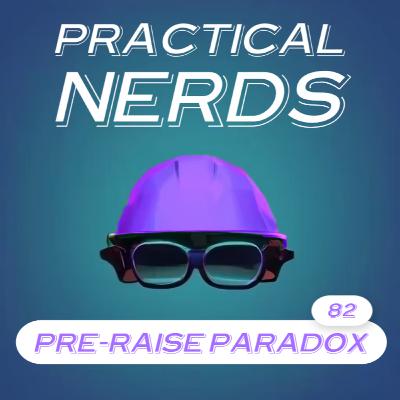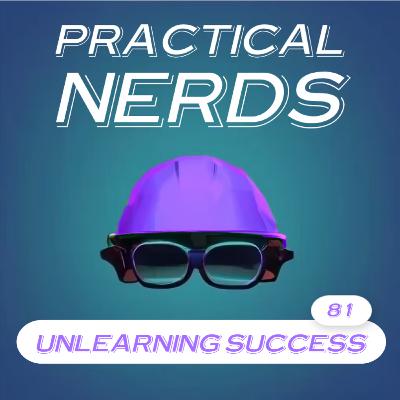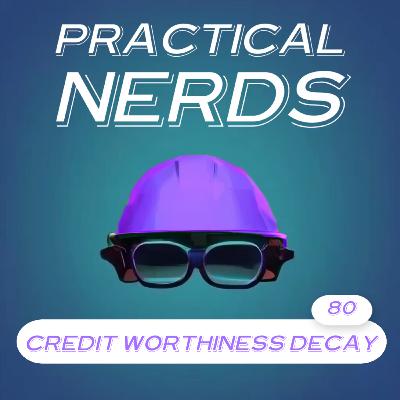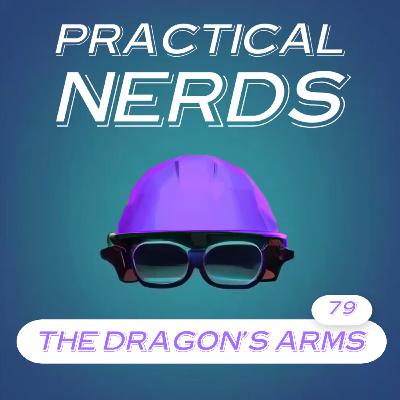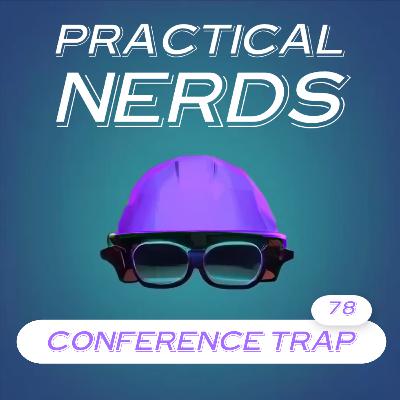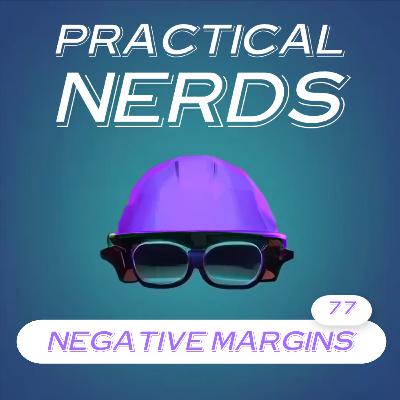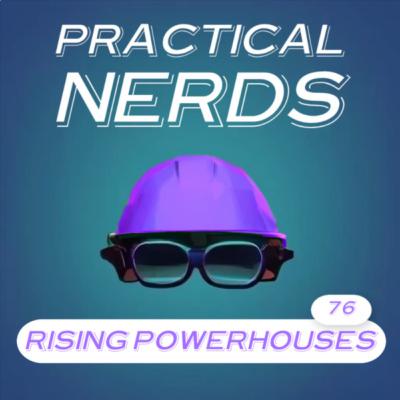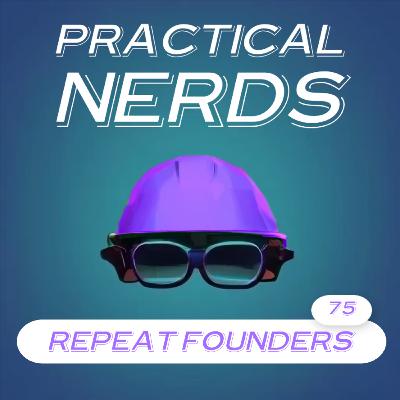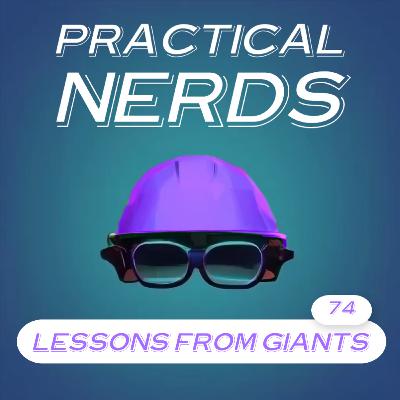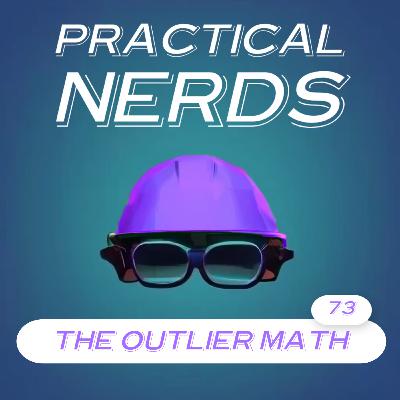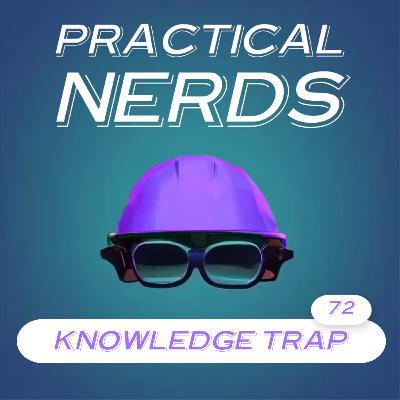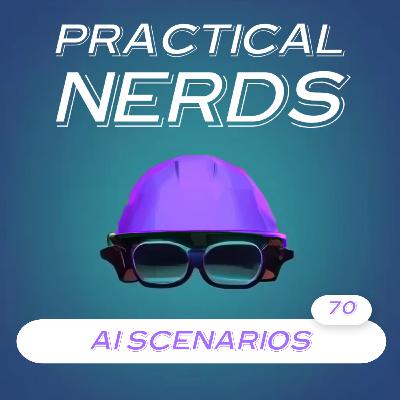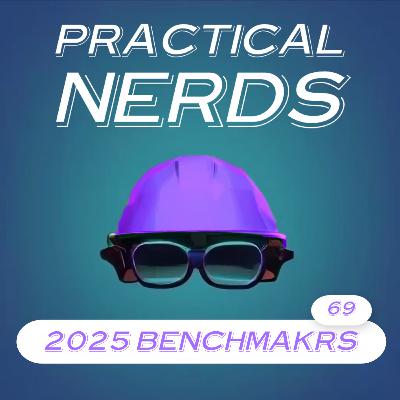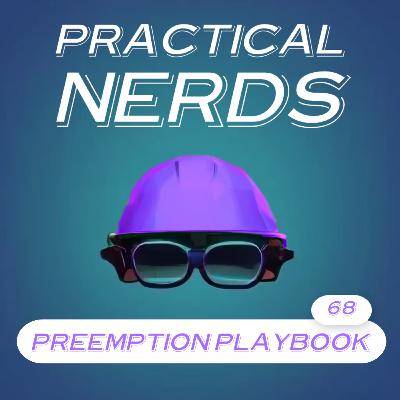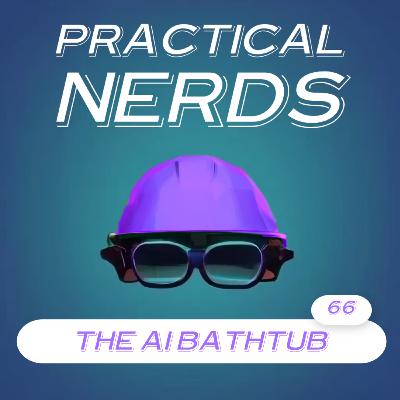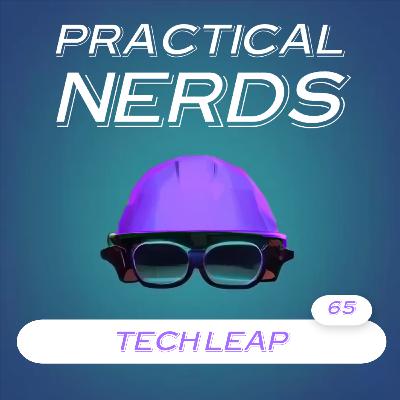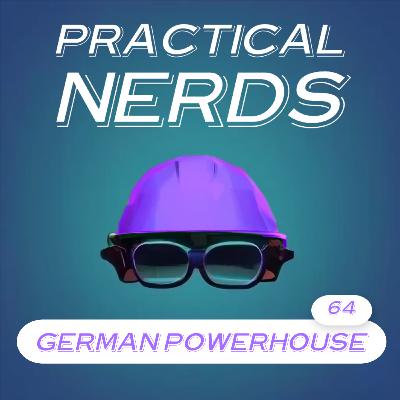Discover Practical Nerds
Practical Nerds

Practical Nerds
Author: Patric Hellermann
Subscribed: 1Played: 53Subscribe
Share
© Patric Hellermann
Description
The latest in venture and technology in the real world, from construction-tech to design-tech. Two early-stage investors shooting the breeze about startups, founders and venture funding. We talk about design, construction, renovation, blue-collar, robotics and supply chains. Hosted by Patric Hellermann and Shub Bhattacharya, General Partners at Foundamental (www.foundamental.com).
83 Episodes
Reverse
About This EpisodeIn this candid episode, Patric and Shub explore the challenging side of founder-VC relationships by sharing their most difficult experiences with concerning founder behaviors. They examine patterns of deceptive, manipulative, and hostile conduct they've encountered in the AEC startup ecosystem and discuss whether extreme personality traits are necessary for building outlier companies.In This EpisodeIdentifying concerning behavior patterns and their manifestation in startup foundersExperiences with founders who fabricated term sheets and manipulated VC relationships to create false bidding warsExamples of hostile founder reactions when facing rejection or difficult conversationsThe most challenging case studies including founders with surprisingly few professional references across long careersWhether extreme traits are required for building successful AEC and construction technology companiesTimestamps(00:33) - Introduction and Seinfeld reference setup(03:11) - Defining the psychology aspect of VC work and founder evaluation(06:18) - First category: Deceptive and manipulative behavior examples(09:08) - Shub's story of a founder who falsely claimed term sheet offers(17:47) - Patric's example of founders fabricating existing term sheets(24:38) - Additional example of founders misrepresenting VC conversations(31:11) - Second category: Hostility and aggressive reactions(34:19) - Stories of founders making threats after receiving pass decisions(41:32) - Third category: Most extreme challenging cases(51:48) - The founder with zero professional references across four companies(01:00:35) - Final discussion: Do you need extreme personalities to build outlier companies?(01:07:30) - Conclusion and wrap-upConnect With UsPractical Nerds Website: https://practicalnerds.com/Subscribe to the Newsletter: https://www.linkedin.com/newsletters/practical-nerds-7180899738613882881/Foundamental: https://www.foundamental.com/Patric Hellermann: https://www.linkedin.com/in/aecvc/Shub Bhattacharya: https://www.linkedin.com/in/shubhankar-bhattacharya-a1063a3/Youtube: https://www.youtube.com/@foundamentalvcThe Daily Blueprint: https://tinyurl.com/the-daily-blueprint#FounderBehavior #VentureCapital #StartupPsychology
About This EpisodeIn this episode of Practical Nerds, Patric and Shub share their candid observations from reviewing thousands of startup pitches at Foundamental. They discuss the most common gaps they see in founder presentations and what they wish more founders understood about the fundraising process, offering practical insights for construction tech and AEC startups looking to improve their pitch and execution strategy.In This EpisodeThe critical importance of having extremely specific tactical plans before fundraising, including detailed execution strategies for the next 6 months rather than vague ambitionsWhy founders should actively seek out and acknowledge bottlenecks in their business, from personal weaknesses to competitive challenges, rather than avoiding uncomfortable truthsThe power of maintaining direct access to primary information as a founder, including customer conversations and sales calls, rather than delegating information collectionUnderstanding fundraising as capital allocation and recognizing that raising money means trading company ownership for resources that must generate returnsThe difference between research and experimentation, and why founders need strong hypotheses before running experiments rather than using fundraising to "figure things out"Timestamps(00:00) Introduction and Thanksgiving in Japan banter(02:00) Overview: What founders get wrong about pitching and fundraising (03:56) The lack of tactical specificity in founder plans(09:01) Why founders delay tactical planning and the gym workout analogy(14:34) The importance of identifying and acknowledging bottlenecks(20:48) Founders who delegate information collection versus staying hands-on(24:37) Examples from successful CEOs who maintain founder-led product and sales(26:56) Founders as capital allocators and the cost of equity(32:40) Wrap-upResources or Companies MentionedFaktus: https://faktus.eu/Nvidia: https://www.nvidia.com/en-us/Palantir: https://www.palantir.com/Connect With UsPractical Nerds Website: https://practicalnerds.com/Subscribe to the Newsletter: https://www.linkedin.com/newsletters/practical-nerds-7180899738613882881/Foundamental: https://www.foundamental.com/Patric Hellermann: https://www.linkedin.com/in/aecvc/Shub Bhattacharya: https://www.linkedin.com/in/shubhankar-bhattacharya-a1063a3/Youtube: https://www.youtube.com/@foundamentalvcThe Daily Blueprint: https://tinyurl.com/the-daily-blueprint#StartupFundraising #FounderMindset #VentureCapital
About This EpisodeIn this episode of Practical Nerds, Patric and Shub explore a critical question for venture capitalists: how do you know when your investment playbook needs to evolve? Drawing parallels from the evolution of software companies (from on-premise to SaaS) and the mobile app revolution, they discuss the challenge of recognizing phase shifts in the market before it's too late. The conversation examines strategies for staying relevant in venture capital, from focusing on timeless founder qualities to actively hunting emerging markets, with particular relevance for investors in construction tech, supply chain, and deep tech spaces.In This EpisodeWhy successful investment strategies eventually become obsolete and how VCs can recognize when they're in the middle of a phase shiftThe danger of confirmation bias when evaluating founders, including real examples of VCs using irrelevant criteria like "was a debater in high school" to justify investmentsHow the transition from e-commerce to enterprise SaaS left many investors struggling to adapt, and what this means for construction and supply chain investors todayFive distinct strategies VCs can use to stay relevant: refining founder taste, moving to growth stage, building massive portfolios, developing prepared minds for emerging markets, or trying to be experts in everythingWhy more than 50% of value in outperforming funds comes from emerging markets (geographic or thematic), making phase shift detection the core business of venture capitalThe unique advantage millennials have in adapting to rapid change, having experienced the transition from offline to internet to mobile to social media firsthandTimestamps(00:00) Introduction and Severance reference(01:50) Why successful companies and investment strategies eventually fail(05:20) The software transition from on-premise to SaaS as a case study(10:00) The apprenticeship nature of venture capital and the Midas touch bias(12:30) How the mobile app era caught many investors off guard(15:20) Real examples of investors applying irrelevant B2C playbooks to construction and B2B companies(18:30) The challenge of evaluating "inventions" versus traditional startups in supply chain and deep tech(19:15) How do you know you're in a phase shift?(22:00) The information overload generation and constant phase shifts(26:40) Strategies for dealing with continuous market evolution(28:30) Strategy 1: Reverting to timeless founder evaluation(34:20) Real examples of poor founder evaluation criteria from investors(40:30) The confirmation bias in "founders who know their blind spots"(42:40) Why big VC firms struggle with hardware despite backing Intel and Apple(43:50) Strategy 2: Building prepared minds and picking emerging markets early(45:15) The Airbnb example and emerging category recognition(45:50) Fun anecdote about founder disputes post-fundingResources or Companies MentionedAirbnb:MicrosoftAdobeSAPIntuitAutodeskAppleNvidiaIntelAndurilConnect With UsPractical Nerds Website: https://practicalnerds.com/Subscribe to the Newsletter: https://www.linkedin.com/newsletters/practical-nerds-7180899738613882881/Foundamental: https://www.foundamental.com/Patric Hellermann: https://www.linkedin.com/in/aecvc/Shub Bhattacharya: https://www.linkedin.com/in/shubhankar-bhattacharya-a1063a3/Youtube: https://www.youtube.com/@foundamentalvcThe Daily Blueprint: https://tinyurl.com/the-daily-blueprint#VentureCapital #ConstructionTech #EmergingMarkets
About This EpisodeIn this candid conversation, Patric and Shub explore one of the most challenging aspects of building a startup: when co-founder relationships break down. Using the financial concept of "decay of credit worthiness," they discuss why founder misalignment becomes more likely over time, how to recognize the warning signs, and practical strategies for addressing performance gaps before they destroy company value.In This EpisodeWhy founder teams with 4+ members face over 50% likelihood of co-founder conflict over a 10-year periodThe "decay of credit worthiness" framework: how co-founder compatibility naturally erodes over time due to changing circumstances, ambitions, and external pressuresWarning signs of founder misalignment, from skill gaps to diverging values, and why close personal relationships can actually mask performance issuesPractical communication strategies for addressing co-founder concerns, including the importance of identifying bottlenecks before escalating to difficult conversationsHow to seek objective outside perspective when evaluating co-founder situations, including the specific criteria for choosing the right advisorsTimestamps(00:00) Introduction and casual banter(02:12) The founder misalignment problem: why it's a top cause of startup failure(03:58) The "decay of credit worthiness" metaphor explained(07:50) How to re-underwrite your co-founders over time(10:51) Can investors spot founder misalignment from the outside?(13:15) Why founders avoid confronting co-founder issues(14:52) How team size amplifies risk: from 2 to 4+ co-founders(17:00) The dangers of founder cliques and investor camps(19:44) When close friendships create blind spots(23:14) Communication strategies: starting the difficult conversation(25:59) Identifying and solving bottlenecks before escalating(29:24) Why adjusting compensation doesn't fix fundamental mismatches(32:00) Finding objective advisors: the four critical criteria(36:42) Conclusion and final adviceConnect With UsPractical Nerds Website:https://practicalnerds.com/Subscribe to the Newsletter: https://www.linkedin.com/newsletters/practical-nerds-7180899738613882881/Foundamental: https://www.foundamental.com/Patric Hellermann: https://www.linkedin.com/in/aecvc/Shub Bhattacharya: https://www.linkedin.com/in/shubhankar-bhattacharya-a1063a3/Youtube: https://www.youtube.com/@foundamentalvcThe Daily Blueprint: https://tinyurl.com/the-daily-blueprint#ConstructionTech #StartupFounders #CoFounderRelationships
About This EpisodeShub Bhattacharya shares firsthand insights from attending one of China's largest robotics and automation trade fairs in Shanghai, an event spanning 500,000 square meters with 18 exhibition halls. The conversation reveals six critical observations about China's robotics ecosystem that every AEC technology founder and investor should understand, from unprecedented scale and capital access to cost asymmetries and execution efficiency.In This EpisodeChina's robotics industry operates at a mind-boggling scale, with trade exhibitions filling venues equivalent to 90 football fields and installing 10 times more robots than major Western markets combined in 2024Chinese robotics manufacturers benefit from systematic access to cheap debt, government subsidies, and export tax credits, creating structural advantages that enable rapid capacity building and competitive pricingSignificant cost asymmetry exists between Chinese and Western markets, with identical robotics products selling for three to six times more in Western markets compared to their Chinese domestic pricingRobotic arms have become commoditized in China, with nearly every manufacturer offering multiple arm variations across horizontal use cases rather than focusing on vertical specializationChinese robotics companies demonstrate remarkable capital efficiency, achieving substantial revenue scale and multi-geography operations with significantly lower capital requirements and burn rates compared to Western counterpartsTimestamps(00:00) Introduction(01:26) Why Shub traveled to China and the importance of the robotics trade fair(02:51) First takeaway: China's mind-boggling scale in robotics(06:05) Visualizing the exhibition venue: 500,000 square meters across 18 halls(14:21) Second takeaway: Access to cheap capital, debt, and government subsidies(18:18) The Nvidia analogy: How cost advantages can overcome technology leadership(26:42) Third takeaway: Cost asymmetry between Chinese and Western markets(29:50) Fourth takeaway: Robotic arms as a commodity product(32:22) Fifth takeaway: Product-focused rather than application-focused marketing(38:33) Sixth takeaway: Capital efficiency and VC funding in Chinese robotics(43:28) Why founders and investors must gain primary information from China(44:43) Conclusion and wrap-upResources or Companies MentionedNvidia: https://www.nvidia.com/en-us/Connect With UsPractical Nerds Website: https://practicalnerds.com/Subscribe to the Newsletter: https://www.linkedin.com/newsletters/practical-nerds-7180899738613882881/Foundamental: https://www.foundamental.com/Patric Hellermann: https://www.linkedin.com/in/aecvc/Shub Bhattacharya: https://www.linkedin.com/in/shubhankar-bhattacharya-a1063a3/Youtube: https://www.youtube.com/@foundamentalvcThe Daily Blueprint: https://tinyurl.com/the-daily-blueprint#Robotics #ChinaManufacturing #AECTech
About This EpisodeIn this candid discussion, Patric and Shub dive deep into their personal philosophies on conferences and events within the AEC startup and venture capital ecosystem. They explore why the events industry rebounded stronger than ever post-COVID, despite digital collaboration becoming more sophisticated, and share their contrarian views on optimal time allocation for fund managers and founders in the construction technology space.In This EpisodeHow the COVID pandemic failed to permanently shift the conference industry toward digital collaboration, and why in-person events are more popular than ever in AEC venture capitalThe ROI framework for evaluating conference attendance, including how portfolio strategy (concentrated vs diversified) should influence a fund manager's event calendar in the construction technology sectorWhy many AEC founders and VCs fall into validation-seeking echo chambers at conferences instead of focusing on core business bottlenecks like capital allocation and customer acquisitionThe cultural differences in networking approaches between American, European, and Indian AEC markets, and how relationship-building varies across these regionsWhy attending conferences specifically for fundraising purposes often backfires for both fund managers seeking LPs and AEC startups pursuing venture capitalTimestamps(00:00) - Introduction and recording setup(01:31) - Discussion on lifestyle choices and travel preferences(03:03) - COVID's impact on the events industry and digital collaboration(05:13) - The conference industry's stronger-than-ever comeback(06:59) - Personal ROI framework for conference attendance(08:24) - Shub's perspective on industry outliers and time allocation(10:19) - Capital allocator feedback on fund managers' event attendance(13:31) - Portfolio strategy: concentrated vs diversified approaches and conference relevance(18:33) - Echo chambers and validation seeking in the AEC community(20:29) - Founder case study: prioritizing conferences over business fundamentals(23:49) - The bottleneck identification framework for strategic decision making(25:22) - Thought experiment: hiring a CEO who spends 50% time at conferences(28:00) - Social validation and dopamine hits from event attendance(31:28) - High-value event formats: the House of Cards example(33:10) - Cultural differences in networking: India vs US vs Europe(36:05) - Conference attendance for fundraising purposes(40:00) - Conclusion and travel wishesResources or Companies MentionedHouse of Cards: Referenced TV show discussing high-level business networking eventsS&P 500: Mentioned as performance benchmark for fund returnsConnect With UsPractical Nerds Website: https://practicalnerds.com/Subscribe to the Newsletter: https://www.linkedin.com/newsletters/practical-nerds-7180899738613882881/Foundamental: https://www.foundamental.com/Patric Hellermann: https://www.linkedin.com/in/aecvc/Shub Bhattacharya: https://www.linkedin.com/in/shubhankar-bhattacharya-a1063a3/Youtube: https://www.youtube.com/@foundamentalvcThe Daily Blueprint: https://tinyurl.com/the-daily-blueprint#ConTech #VentureCapital #AECStartups
About This EpisodeIn this episode, Patric and Shub dive deep into negative gross margins as a predictive indicator of market froth in venture capital. They explore why businesses that lose money on every transaction they complete represent a fundamental misunderstanding of value creation, particularly in the AEC and B2B technology sectors.In This EpisodeHow gross margin reflects whether customers truly find value in what you're delivering and serves as a measure of pricing power in competitive marketsWhy negative gross margin businesses fundamentally contradict the purpose of capital allocation and represent value destruction rather than creationHistorical examples of negative gross margin bubbles including scooter companies like Lime and Bird, quick commerce platforms, and their inevitable market correctionsThe current AI and LLM industry's troubling trend toward negative gross margins, with detailed analysis of companies like Cursor paying more to AI providers than they generate in revenueCommon window dressing techniques founders use to disguise poor unit economics and why clean financial reporting starts with honest gross margin calculationsTimestamps(00:00) - Introduction and discussion about their break(02:17) - Introduction of negative gross margins as market froth indicator(02:55) - Definition and explanation of gross margin across different business models(09:54) - The fundamental question: does your customer find value?(18:49) - Historical examples: scooter businesses and quick commerce failures(25:23) - Why negative gross margin businesses still attract funding(31:28) - AI and LLM industry analysis: Anthropic, Cursor, and GitHub Copilot case study(39:46) - Window dressing techniques and financial reporting tricks(42:23) - Conclusion and final thoughts on B2B vs B2C differencesResources or Companies MentionedAnthropic: https://www.anthropic.comCursor: https://www.cursor.soGitHub Copilot: https://github.com/features/copilotLime: https://www.li.meBird: https://www.bird.coPerplexity: https://www.perplexity.aiOpenAI: https://openai.comConnect With UsPractical Nerds Website: https://practicalnerds.com/Subscribe to the Newsletter: https://www.linkedin.com/newsletters/practical-nerds-7180899738613882881/Foundamental: https://www.foundamental.com/Patric Hellermann: https://www.linkedin.com/in/aecvc/Shub Bhattacharya: https://www.linkedin.com/in/shubhankar-bhattacharya-a1063a3/Youtube: https://www.youtube.com/@foundamentalvcThe Daily Blueprint: https://tinyurl.com/the-daily-blueprint#VentureCapital #GrossMargin #AECTech
About This Episode Germany and India have officially become the world's third and fourth largest economies respectively, with India surpassing Japan in recent quarters. In this episode, Patric and Shub dive deep into the massive capital mobilization happening in both countries, exploring Germany's "Made for Germany" initiative that's mobilizing over 4 trillion dollars in investment and India's continued 6-7% growth trajectory that's transforming its infrastructure and construction landscape.In This EpisodeGermany's "Made for Germany" initiative and the mobilization of over 4 trillion dollars in government-backed and private investment for infrastructure, defense, and manufacturing resilienceIndia's rise to become the fourth largest global economy and the infrastructure boom driving double-digit growth in construction and AEC sectorsThe energy infrastructure revolution in Germany, including fusion energy breakthroughs and the buildout of renewable power distribution networksIndia's transition from agricultural to urban manufacturing economy and the massive infrastructure development creating opportunities in construction techBureaucratic challenges and capital market accessibility issues that both countries must address to fully capitalize on their economic momentumTimestamps(00:31) - Introduction and discussion of Germany and India as 3rd and 4th largest economies(02:13) - Germany's "Made for Germany" initiative and 4 trillion dollar investment mobilization(08:56) - Analysis of Germany as an undervalued asset class and investment opportunity(17:46) - German infrastructure priorities: energy, transportation, and manufacturing(22:46) - Fusion energy breakthroughs and Germany's energy infrastructure strategy(25:17) - India's economic update and rise to 4th largest global economy(28:17) - India's venture ecosystem and middle-income country transition challenges(38:30) - Indian diaspora influence and human capital exports(40:30) - Drivers behind India's sustained 6-7% economic growth(45:17) - Consumer demand patterns and manufacturing opportunities in India(51:55) - Capital market accessibility challenges and bureaucratic reform needsResources or Companies MentionedKKR: https://www.kkr.com/EQT: https://eqtgroup.com/SAP: https://www.sap.com/Siemens: https://www.siemens.com/Heidelberg Materials: https://www.heidelbergmaterials.com/Zepto: https://www.zeptonow.com/Apple: https://www.apple.com/Connect With UsPractical Nerds Website: https://practicalnerds.com/Subscribe to the Newsletter: https://www.linkedin.com/newsletters/practical-nerds-7180899738613882881/Foundamental: https://www.foundamental.com/Patric Hellermann: https://www.linkedin.com/in/aecvc/Shub Bhattacharya: https://www.linkedin.com/in/shubhankar-bhattacharya-a1063a3/Youtube: https://www.youtube.com/@foundamentalvcThe Daily Blueprint: https://short.foundamentals.io/s/the-daily-blueprint#GlobalEconomies #InfrastructureInvestment #AECTech
About This EpisodeIn this episode, Patric Hellermann and Shub Bhattacharya explore their investment thesis on repeat founders in construction tech, examining whether being a repeat founder is actually a valuable signal for investment decisions. They dive deep into the psychology of entrepreneurship, discussing the difference between personality traits and experience layers, and why "unreasonable" founders might be key to achieving asymmetric returns. The hosts reveal the counterintuitive insight that previous success might actually make founders more conformist and reasonable, potentially reducing their chances of achieving another breakthrough outcome.In This EpisodeHow repeat founders are increasingly entering the construction tech space as it becomes viewed as a legitimate frontier for high-quality entrepreneurs seeking their next venture.The critical distinction between personality traits and experience layers when evaluating repeat founders, and why personality characteristics formed during formative years often matter more than entrepreneurial experience.The concept of "unreasonable" founders and why this rare personality trait is essential for building truly transformative companies that can achieve massive outcomes.Why successful repeat founders often become more conformist and reasonable over time, potentially reducing their ability to achieve another breakthrough success.The importance of accountability and responsibility-taking as a key indicator of whether a repeat founder has genuinely learned from their previous experiences.Timestamps(00:00) - Introduction and the construction tech thesis(01:18) - Why repeat founders are entering construction tech(04:37) - Framework for evaluating repeat founders: Personality vs Experience layers(09:52) - The limited value of avoiding first-time founder mistakes(12:30) - How repeat founders should articulate learned trade-offs and sacrifices(18:02) - The danger of using success as a shortcut to skip personality diligence(21:21) - The rarity of truly "unreasonable" people and why this matters for founders(26:05) - How entering construction tech might be a form of conformity for some repeat founders(28:18) - The importance of internalizing blame and responsibility as a repeat founder(35:34) - Real-world example of investor behavior around repeat founders(41:38) - Why being a repeat founder alone is not instructive for predicting success(44:15) - Conclusion and wrap-upResources or Companies MentionedY Combinator: https://www.ycombinator.com/Connect With UsPractical Nerds Website: https://practicalnerds.com/Subscribe to the Newsletter: https://www.linkedin.com/newsletters/practical-nerds-7180899738613882881/Foundamental: https://www.foundamental.com/Patric Hellermann: https://www.linkedin.com/in/aecvc/Shub Bhattacharya: https://www.linkedin.com/in/shubhankar-bhattacharya-a1063a3/Youtube: https://www.youtube.com/@foundamentalvcThe Daily Blueprint: https://tinyurl.com/the-daily-blueprint#RepeatFounders #ConstructionTech #VentureCapital
About This EpisodeIn this episode of Practical Nerds, hosts Patric Hellermann and Shub Bhattacharya dive deep into what makes a truly exceptional business model. Drawing from analysis of over 1,150 top companies, they explore the characteristics that separate great businesses from merely good ones, with particular focus on how these principles apply to architecture, engineering, and construction (AEC) startups and technology companies.In This EpisodeHyper-Repeatable Units of Supply: How companies like cement manufacturers (Holcim, Heidelberg, CRH) and Coca-Cola create scalable business models through standardized products that can be industrialized globallyMonopolistic Characteristics and Toll Booth Businesses: The power of owning assets that others must utilize, from payment processors like Visa to technical certification bodies like TÜV, and how AEC companies can build similar moatsCost Structure Advantages: Converting variable costs to fixed costs and selling them back as variable services, illustrated through examples from payments processing to construction formwork systemsMulti-Supply Capacity and Geographic Diversification: How companies like PERI (formwork systems) build resilience through diverse product offerings and global footprints in construction marketsPredictability vs. Disruption: Learning from companies like BlackBerry and Kodak that failed to adapt, and how modern businesses can build flexibility into their modelsBig Bet Taking at Scale: Examining which large companies still successfully take major strategic risks, from Amazon's continued innovation to Reliance's Jio transformationTimestamps(00:00) - Introduction(01:35) - Defining what makes a great business model(05:01) - Hyper-repeatable units of supply in construction materials(07:42) - Monopolistic characteristics and toll booth dynamics(18:56) - Cost structure advantages and fixed vs. variable costs(28:09) - Predictability and resilience in business models(33:52) - Multi-supply capacity and diversification strategies(41:34) - The role of automation and capacity creation(47:17) - Big bet taking at scale in established companies(53:59) - Conclusion and wrap-upResources or Companies MentionedPERI Formwork Systems: https://www.peri.com/SAP: https://www.sap.com/Holcim: https://www.holcim.com/Heidelberg Materials: https://www.heidelbergmaterials.com/Connect With UsPractical Nerds Website: https://practicalnerds.com/Subscribe to the Newsletter: https://www.linkedin.com/newsletters/practical-nerds-7180899738613882881/Foundamental: https://www.foundamental.com/Patric Hellermann: https://www.linkedin.com/in/aecvc/Shub Bhattacharya: https://www.linkedin.com/in/shubhankar-bhattacharya-a1063a3/Youtube: https://www.youtube.com/@foundamentalvcThe Daily Blueprint: https://tinyurl.com/the-daily-blueprint#ConstructionTech #BusinessStrategy #AECInnovation
About This EpisodePatric and Shub challenge fundamental venture capital assumptions by analyzing why traditional VC focuses on horizontal software companies when 95% of the world's most valuable companies are vertical, sector-specific businesses. Using Six Sigma methodology and construction industry data, they make a compelling case for why AEC startups have better odds of becoming "decacorns" than traditional tech companies.In This EpisodeStatistical analysis revealing that only 50-70 tech companies achieve decacorn status (10+ billion valuation) while over 1,000 traditional companies surpass this threshold, challenging the venture capital playbookThe shocking discovery that only 3% of unicorns graduate to decacorn status, a lower success rate than seed to Series A funding rounds, raising questions about venture capital's scaling assumptionsDeep dive into construction industry economics showing 115 off-spec companies generating $3.14 trillion in combined revenue, demonstrating the massive scale potential in vertical marketsComparison between "thin slice" horizontal companies that capture 1-2% of customer spend across multiple industries versus vertically integrated companies that can capture 25-50% of spend within their specific marketTimestamps(00:00) - Introduction and dancing skills revelation(02:30) - Six Sigma analysis of global company valuations and the 1,130 off-spec threshold(15:00) - Unicorn to decacorn graduation rates and the 3% success barrier(26:00) - Construction industry deep dive and the $3.14 trillion market opportunity(34:00) - Thin slice versus thick slice market capture analysis(43:00) - Examples of successful vertical companies: SpaceX, Tesla, BYD, and Anduril(46:00) - Conclusion and closing thoughts on venture capital's adverse selectionResources or Companies MentionedMonster Beverage: https://www.monsterbevcorp.comWeWork: https://www.wework.comStripe: https://stripe.comDatabricks: https://www.databricks.comSnowflake: https://signup.snowflake.comCrowdStrike: https://www.crowdstrike.comAnduril: https://www.anduril.comSunTech: https://www.suntech-power.comCaterpillar: https://www.caterpillar.comCRH: https://www.crh.comHolcim: https://www.holcim.comSaint-Gobain: https://www.saint-gobain.comKingspan: https://www.kingspan.comBouygues: https://www.bouyguestelecom.frVinci: https://www.vinci.comArcadis: https://www.arcadis.com/enPalantir: https://www.palantir.comKlarna: https://www.klarna.comChime: https://www.chime.comConnect With UsPractical Nerds Website: https://practicalnerds.com/Subscribe to the Newsletter: https://www.linkedin.com/newsletters/practical-nerds-7180899738613882881/Foundamental: https://www.foundamental.com/Patric Hellermann: https://www.linkedin.com/in/aecvc/Shub Bhattacharya: https://www.linkedin.com/in/shubhankar-bhattacharya-a1063a3/Youtube: https://www.youtube.com/@foundamentalvcThe Daily Blueprint: https://tinyurl.com/the-daily-blueprint#Decacorns #ConstructionTech #VentureCapital
About This EpisodeIn this thought-provoking discussion, Patric Hellermann and Shub Bhattacharya examine "The Illusion of Knowledge" - how professionals, particularly in venture capital and construction technology, often make critical decisions based on filtered information rather than primary data. They explore the tendency to mistake assumptions for facts and discuss how this impacts decision-making in AEC startups and technology investments.In This EpisodeThe Dunning-Kruger effect in entrepreneurship and venture capital and how it leads to poor investment decisions in construction technology startupsWhy relying on curated briefings and secondhand information creates the same problems for VCs that plague government officials and politiciansThe critical importance of acquiring primary details directly from customers, users, and the field before making investment or strategic decisions in AEC companiesHow the amplification of misinformation through social media has made it harder to distinguish between genuine expertise and false confidence in construction technologyThe difference between helpful biases (taste and pattern recognition) and harmful biases that lead to manipulation and poor decision-makingWhy founder-led companies typically make better decisions than those run by employed CEOs, especially in the AEC sectorTimestamps(00:00) - Introduction and discussion of feeling intelligent vs. actually knowing(02:00) - The illusion of knowledge concept and how it manifests in different crises and trends(06:00) - The Dunning-Kruger effect and its amplification through social media(11:00) - How politicians and VCs both suffer from filtered information problems(15:00) - The importance of getting primary details to make prime decisions(20:00) - Taking accountability and ownership over investment decisions(27:00) - Spotting false expertise and the problem of loud voices without knowledge(30:00) - When biases are helpful vs. harmful in decision-making(37:00) - The impact of social media on information quality and decision-making(41:00) - Conclusion and final thoughts on employed vs. owner CEOsConnect With UsPractical Nerds Website: https://practicalnerds.com/Subscribe to the Newsletter: https://www.linkedin.com/newsletters/practical-nerds-7180899738613882881/Foundamental: https://www.foundamental.com/Patric Hellermann: https://www.linkedin.com/in/aecvc/Shub Bhattacharya: https://www.linkedin.com/in/shubhankar-bhattacharya-a1063a3/Youtube: https://www.youtube.com/@foundamentalvcThe Daily Blueprint: https://tinyurl.com/the-daily-blueprint#DecisionMaking #VentureCapital #ConstructionTech
About This EpisodeIn this provocative 2-year anniversary episode, Patric and Shub use Netflix's Ozark as a satirical metaphor to examine what they see as potential systematic issues in the current AI venture capital ecosystem. They muse about the possibility if many generic VCs could be creating artificial demand by funding AI companies that primarily sell to other VC-backed startups (funded by their friends and vice versa), and discuss how legitimate construction tech companies using AI can protect themselves from potential fallout when this cycle ends.In This EpisodeHow the current AI VC ecosystem (satirically) mirrors the money laundering schemes depicted in Netflix's Ozark, with investors controlling both sides of transactionsThe observation that many horizontal AI startups achieving high ARR primarily by selling to other VC-backed companies rather than genuine enterprise customersHow it could be that some AI companies are operating with negative gross margins while claiming rapid growth, and what this means for the sustainability of the sectorStrategic advice for construction technology companies that legitimately use AI to differentiate themselves from speculative bubblesThe potential consequences when the current AI investment cycle ends and how it could impact even genuine AI innovations in architecture, engineering, and constructionTimestamps(00:00) - Introduction and 2-year anniversary celebration(02:00) - Setting up the Ozark metaphor and "cabaret" discussion format(07:00) - Explaining money laundering principles from Ozark(15:00) - Drawing parallels between Ozark and current AI VC practices(25:00) - Discussing the breaking point and sustainability concerns(35:00) - Advice for construction tech companies using AI(42:00) - Real examples of negative gross margin AI companies(45:00) - Government connections and regulatory implications(47:00) - Conclusion and wrap-upResources or Companies MentionedOpenAI: https://openai.com/Amazon: https://www.amazon.com/Autodesk: https://www.autodesk.com/Connect With UsPractical Nerds Website: https://practicalnerds.com/Subscribe to the Newsletter: https://www.linkedin.com/newsletters/practical-nerds-7180899738613882881/Foundamental: https://www.foundamental.com/Patric Hellermann: https://www.linkedin.com/in/aecvc/Shub Bhattacharya: https://www.linkedin.com/in/shubhankar-bhattacharya-a1063a3/Youtube: https://www.youtube.com/@foundamentalvcThe Daily Blueprint: https://tinyurl.com/the-daily-blueprint#AIInvesting #ConstructionTech #VentureCapital
About This EpisodeIn this thought-provoking episode, Patric Hellermann and Shub Bhattacharya engage in an unscripted discussion about the existential threats AI poses to the construction technology ecosystem and their venture capital business. The hosts explore how different levels of artificial intelligence might impact their portfolio companies and challenge fundamental business models in architecture, engineering, and construction.In This EpisodeConstruction fundamentally involves moving and stacking atoms, which limits how AI can disrupt the physical aspects of the industry while still impacting information flows and decision-making.Intermediaries in construction supply chains whose value is based on managing relationships and complexity may see their roles diminished as AI improves orchestration and automation.The hosts challenge the Silicon Valley narrative that AI agents will replace SaaS companies, noting that established software platforms are incorporating AI rather than being displaced by it.Early-stage venture capital's reliance on intuition, founder assessment, and non-consensus thinking provides some defense against AI disruption, unlike growth-stage investing which could be more easily automated.Timestamps(00:00) - Introduction(01:23) - Discussing AI's impact on portfolio companies across construction tech(04:07) - Construction's fundamental nature as "moving atoms" and AI limitations(11:09) - How AI might affect intermediaries in construction supply chains(17:29) - Examining if AI makes SaaS companies less valuable or more entrenched(22:19) - Could AI disrupt venture capital itself?(27:11) - The value of non-consensus thinking versus AI-driven investing(35:19) - Differences between early-stage and growth investing in an AI world(37:44) - How early-stage VCs can defend against AI disruptionResources or Companies MentionedOpenAI: https://openai.comSalesforce: https://www.salesforce.com/eu/Microsoft: https://www.microsoft.comSAP: https://www.sap.comProcore: https://www.procore.com/Connect With UsPractical Nerds Website: https://practicalnerds.com/Subscribe to the Newsletter: https://www.linkedin.com/newsletters/practical-nerds-7180899738613882881/Foundamental: https://www.foundamental.com/Patric Hellermann: https://www.linkedin.com/in/aecvc/Shub Bhattacharya: https://www.linkedin.com/in/shubhankar-bhattacharya-a1063a3/Youtube: https://www.youtube.com/@foundamentalvcThe Daily Blueprint: https://tinyurl.com/the-daily-blueprint#AIinConstruction #VentureCapital #ConstructionTech
About This EpisodeIn this episode of Practical Nerds, Patric Hellermann and Shub Bhattacharya conduct a detailed financial benchmarking analysis of leading AEC software companies again, comparing them with established SaaS industry leaders. The hosts dive into financial metrics from Autodesk, Bentley Systems, Procore, Adobe, ServiceNow, and Intuit, examining everything from revenue growth to operating margins.In This EpisodePatric and Shub analyze the latest financial data from annual reports of key AEC software companies (Autodesk, Bentley Systems, Procore) and compare them with industry benchmarks (Adobe, ServiceNow, Intuit).The benchmarking reveals Procore's declining growth trajectory, with guidance for only 8% annual growth in 2025, while competitors like Autodesk are projecting faster percentage growth.Financial analysis shows Adobe delivering exceptional performance across metrics despite lower market valuation multiples compared to ServiceNow, highlighting potential market inefficiencies.Bentley Systems emerges as an efficiency standout, achieving remarkable free cash flow margin (31%) despite moderate gross margins (81%), showcasing excellent operational execution.Timestamps(00:00) - Introduction(01:05) - Explanation of the benchmarking exercise and disclaimer(04:06) - Clarification on using GAAP numbers for analysis(04:32) - Financial data collection for Autodesk(09:57) - Financial data collection for Bentley Systems(13:54) - Financial data collection for Procore(18:13) - Financial data collection for Adobe(27:03) - Financial data collection for ServiceNow and Intuit(32:27) - Conclusion of data collection phase(33:09) - Analysis of 2023 benchmarking results(42:19) - Analysis of 2025 benchmarking results(42:47) - Comparison of revenue growth across companies(44:24) - Analysis of gross margin performance(45:56) - Discussion of operating income margins(47:54) - Review of annual revenue per employee(52:28) - Evaluation of the Rule of 40 performance(54:21) - Analysis of sales and marketing intensity(54:59) - Comparison of R&D intensity across companies(56:10) - Review of G&A intensity(57:09) - Analysis of free cash flow margins(58:48) - Discussion of cash conversion scores(59:46) - Comparison of company valuations(01:03:33) - Final thoughts on valuations and founder expectationsResources or Companies MentionedAutodesk: https://www.autodesk.com/deBentley Systems: https://www.bentley.com/Procore: https://www.procore.com/deAdobe: https://www.adobe.com/ServiceNow: https://www.servicenow.com/Intuit: https://www.intuit.com/Connect With UsPractical Nerds Website: https://practicalnerds.com/Subscribe to the Newsletter: https://www.linkedin.com/newsletters/practical-nerds-7180899738613882881/Foundamental: https://www.foundamental.com/Patric Hellermann: https://www.linkedin.com/in/aecvc/Shub Bhattacharya: https://www.linkedin.com/in/shubhankar-bhattacharya-a1063a3/Youtube: https://www.youtube.com/@foundamentalvcThe Daily Blueprint: https://tinyurl.com/the-daily-blueprint#ConstructionTech #SaaSMetrics #FinancialBenchmarking
About This EpisodeIn Episode 68 of Practical Nerds, Patric Hellermann and Shub Bhattacharya dive deep into the concept of "preemption" in venture capital fundraising for construction tech startups. They explore the conditions necessary for successful preemptions, the potential pitfalls, and how founders can navigate this complex process to ensure long-term success.In This EpisodePatric and Shub define preemption in VC fundraising as investors offering capital before a planned financing round, avoiding competition and market processes.The hosts outline the conditions for successful preemptions, including company performance excellence, investor conviction, and the importance of building authentic relationships before any preemption attempt.They discuss the risks of preemptions, particularly valuation challenges where artificially high valuations can create unrealistic expectations for future rounds, potentially setting construction tech startups up for difficult down rounds.The conversation compares internal versus external preemptions, with both hosts favoring internal preemptions from existing investors who already understand the business and have demonstrated alignment with the founder's vision.Timestamps(00:00) - Introduction (01:41) - Defining preemption in VC fundraising context(03:35) - Conditions for successful preemptions(11:42) - How rare successful preemptions actually are(12:09) - Identifying genuine versus opportunistic preemption attempts(16:28) - The valuation trap in preemptions(21:26) - What makes a preemption "done right"(24:32) - Weighing preemption against discovering true market valuation(27:56) - Market volatility as a factor in preemption decisions(32:05) - Internal vs external preemption: which is better for construction tech startups(36:35) - Frequency of successful preemptions in construction techConnect With UsPractical Nerds Website: https://practicalnerds.com/Subscribe to the Newsletter: https://www.linkedin.com/newsletters/practical-nerds-7180899738613882881/Foundamental: https://www.foundamental.com/Patric Hellermann: https://www.linkedin.com/in/aecvc/Shub Bhattacharya: https://www.linkedin.com/in/shubhankar-bhattacharya-a1063a3/Youtube: https://www.youtube.com/@foundamentalvcThe Daily Blueprint: https://tinyurl.com/the-daily-blueprint#VentureCapital #ConstructionTech #Preemption
About This EpisodeIn Episode 67, Patric and Shub explore why transparency about limitations and past failures is crucial for building trust between founders and investors. They discuss how acknowledging constraints doesn't signal weakness but rather demonstrates a professional athlete's mindset of continuous improvement that leads to stronger partnerships and better businesses.In This EpisodePatric explains why investors distrust founders who hide their weaknesses, comparing it to establishing trust in a marriage where honesty about limitations is essential for a strong relationship.Shub discusses how acknowledging constraints is the only way to improve as an individual and organization, using the Theory of Constraints to identify and eliminate bottlenecks.The hosts share real examples of how vague answers, white lies, and glossing over problems during due diligence can completely erode trust and derail potential investments.They examine how exceptional founders and investors are more comfortable discussing their limitations because they know their overall value proposition remains strong despite imperfections.Timestamps(00:00) - Introduction(01:53) - Building trust during the diligence phase(03:30) - The misconception about hiding weaknesses(08:56) - The Theory of Constraints and acknowledging bottlenecks(15:03) - How founders hurt themselves by hiding limitations(16:31) - The professional athlete's mindset(19:15) - Red flags: embellishment and vagueness(22:27) - Cultural differences in acknowledging responsibility(24:42) - Game theory: What hiding weaknesses reveals about you(28:05) - Building emotional bonds through vulnerability(32:26) - The importance of identifying your constraints(35:42) - Conclusion and wrap-upConnect With UsPractical Nerds Website: https://practicalnerds.com/Subscribe to the Newsletter: https://www.linkedin.com/newsletters/practical-nerds-7180899738613882881/Foundamental: https://www.foundamental.com/Patric Hellermann: https://www.linkedin.com/in/aecvc/Shub Bhattacharya: https://www.linkedin.com/in/shubhankar-bhattacharya-a1063a3/Youtube: https://www.youtube.com/@foundamentalvcThe Daily Blueprint: https://tinyurl.com/the-daily-blueprint#ConstructionTech #AIInvestment #DataInfrastructure
About This EpisodeIn this insightful discussion, Patric Hellermann and Shub Bhattacharya explore their investment thesis regarding AI versus data infrastructure, authoring tools, and systems of record in the architecture, engineering, and construction (AEC) technology space. They delve into why companies that serve as the "bathtub" containing AI capabilities may ultimately create more value than pure AI feature companies.In This EpisodePatric and Shub discuss why AI-generated content in construction documents typically requires extensive editing, making authoring tools and systems of record crucial for deterministic outcomes.They explore the "bathtub and water" analogy (credited to Stan from Rayon), where AI is like tap water—ubiquitous but a commodity—while the true value comes from the vessel containing it.The hosts examine various types of "bathtubs" in construction tech, including ERPs, authoring tools for designers, data infrastructure companies, and systems of record that provide structure to unstructured data.Shub and Patric analyze why it's significantly harder for AI-first companies to build data infrastructure around themselves than for infrastructure companies to incorporate AI functionality.Timestamps(00:00) - Introduction(01:55) - Setting up the discussion topic: AI versus authoring tools(05:13) - Thesis on AI-generated content requiring iteration and editing(08:27) - AI becoming ubiquitous like "internet" in investment thesis(13:28) - The "bathtub and water" analogy for AI and data infrastructure(15:27) - Examples of "bathtubs" in construction tech(18:07) - Challenges for AI-first companies trying to build infrastructure(24:23) - The importance of data structuring and infrastructure(28:56) - Agentic AI and its limitations without systems of record(33:20) - Current landscape of system-of-record companies in constructionResources or Companies MentionedAutodesk: Amy Bunszel mentioned regarding investment thesis about AI (https://www.autodesk.com/)Speckle: Referenced as an example for 3D geometric data infrastructure (https://www.speckle.systems/) UiPath: Discussed in context of workflow automation challenges (https://www.uipath.com/)Procore: Mentioned as incumbent system of record for US contractors (https://www.procore.com/de) Glodon: Referenced as a significant player in the Chinese market (https://www.glodon.com/en/)Connect With UsPractical Nerds Website: https://practicalnerds.com/Subscribe to the Newsletter: https://www.linkedin.com/newsletters/practical-nerds-7180899738613882881/Foundamental: https://www.foundamental.com/Patric Hellermann: https://www.linkedin.com/in/aecvc/Shub Bhattacharya: https://www.linkedin.com/in/shubhankar-bhattacharya-a1063a3/Youtube: https://www.youtube.com/@foundamentalvcThe Daily Blueprint: https://tinyurl.com/the-daily-blueprint#ConstructionTech #AIInvestment #DataInfrastructure
About This EpisodeIn this episode, Patric and Shub explore the concept of "leapfrogging" in technology adoption and its potential impact on construction technology. They analyze how markets and companies can skip established development steps to implement more advanced solutions, particularly examining where construction tech might see revolutionary changes through this phenomenon.In This EpisodePatric and Shub define leapfrogging as when users skip incremental technological steps to adopt more advanced solutions, driven by high incremental value in specific markets.The hosts explore historical examples of leapfrogging across different industries and regions, including mobile technology in India, digital payments infrastructure, electric vehicles in China, and super apps like WeChat.Patric presents a compelling thesis that European construction firms might leapfrog the fragmented point-solution approach seen in US construction technology and move directly to integrated tech stacks with custom data infrastructures.The discussion examines how AI might serve as a catalyst for construction technology leapfrogging by accelerating software fatigue and creating opportunities for new entrants to reimagine the entire technology stack.Timestamps(00:00) - Introduction (01:24) - Topic introduction: leapfrogging in construction technology (04:18) - Defining leapfrogging and its principles (05:38) - Examples of leapfrogging from India: mobile technology adoption (07:51) - Infrastructure leapfrogging and mobile adoption patterns (10:37) - Digital payments infrastructure in India as a leapfrogging example (13:30) - Chinese examples: electric vehicles and super apps (17:10) - Drone warfare as a European leapfrogging example (20:03) - Applying leapfrogging concepts to construction technology (21:11) - Cloud manufacturing as a construction tech leapfrogging example (25:10) - Software adoption differences between US and European markets (30:01) - Thesis on how European construction firms might leapfrog in software adoption (33:29) - AI as a catalyst for construction technology leapfrogging (39:56) - Why incumbents may not lead the leapfrogging movement (44:39) - The Chinese AI ecosystem and open source potential (48:38) - Conclusion and strategic implications Resources or Companies MentionedWeChat: https://www.wechat.com/Gojek: https://www.gojek.com/Procore: https://www.procore.com/Connect With UsPractical Nerds Website: https://practicalnerds.com/Subscribe to the Newsletter: https://www.linkedin.com/newsletters/practical-nerds-7180899738613882881/Foundamental: https://www.foundamental.com/Patric Hellermann: https://www.linkedin.com/in/aecvc/Shub Bhattacharya: https://www.linkedin.com/in/shubhankar-bhattacharya-a1063a3/Youtube: https://www.youtube.com/@foundamentalvcThe Daily Blueprint: https://tinyurl.com/the-daily-blueprint#ConstructionTech #Leapfrogging #TechnologyAdoption
About This EpisodeIn this milestone 64th episode of Practical Nerds, hosts Patric Hellermann and Shub Bhattacharya meet in person at their Berlin office to discuss Germany as a construction tech hub. They analyze Germany's position as the world's third-largest economy and explore how a new trillion-euro infrastructure and defense investment plan could create unprecedented opportunities for construction technology companies.In This EpisodeGermany's trillion-euro infrastructure and defense fund signals a major shift from years of fiscal surplus to strategic investment, potentially triggering a construction tech boom across commercial and infrastructure sectors.The hosts discuss Germany's historical pattern of making bold policy decisions during times of change, with previous examples creating prosperity booms that could repeat with the new investment plan.Germany has built competence clusters in specific construction tech areas like energetic renovation and construction robotics, positioning it as a key innovation hub alongside France in the European market.Major American capital is flowing into Europe, with German companies attracting attention for their methodical approach to scaling and their ability to manage multiple bets simultaneously.Timestamps(00:00) - Introduction(03:33) - Germany's significance in the global economy(05:07) - The trillion-euro investment plan and its implications(08:00) - Comparing infrastructure investments across countries(11:30) - Germany's fiscal policies and historical surplus(14:12) - Infrastructure decay and railway challenges(16:06) - German government formation process(25:07) - The European pattern of implementing bold changes(32:31) - German founders' strengths in multi-project management(35:05) - German vs. Indian approaches to business building(44:25) - Exciting construction tech subsectors in Germany(48:10) - Germany and France as leading European markets for construction techResources or Companies MentionedENPAL: Solar installation company and unicorn in Germanyhttps://www.enpal.de/Connect With UsPractical Nerds Website: https://practicalnerds.com/Subscribe to the Newsletter: https://www.linkedin.com/newsletters/practical-nerds-7180899738613882881/Foundamental: https://www.foundamental.com/Patric Hellermann: https://www.linkedin.com/in/aecvc/Shub Bhattacharya: https://www.linkedin.com/in/shubhankar-bhattacharya-a1063a3/#ConstructionTech #GermanEconomy #InfrastructureInvestment



